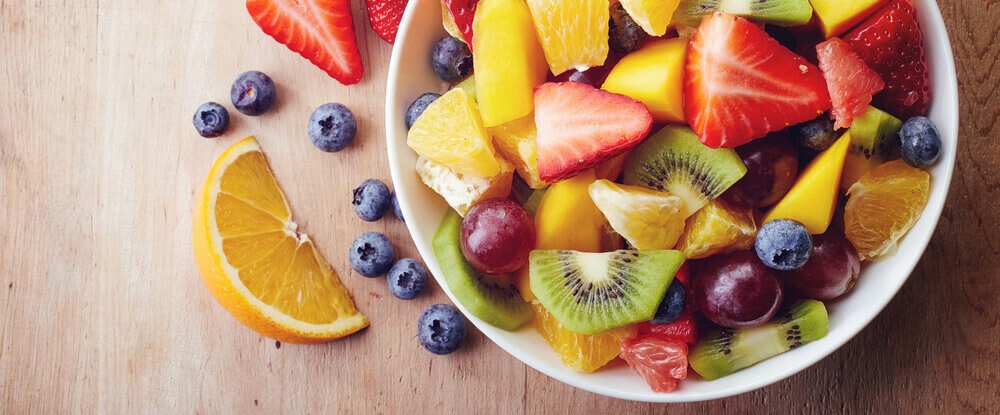Eat Your Fruit!
We know that fruit is part of a healthy diet, and as a result of several published studies, the proof is not just in the pudding, but also in the fruits and vegetables.
 By Susan B. Sloane, BS, RPh, CDE
By Susan B. Sloane, BS, RPh, CDE
One such study called the EPIC Heart study, followed over 300,000 participants for an average of 8.5 years, measuring their fruit and vegetable consumption while monitoring health parameters. The results were quite impressive; participants who consumed eight or more servings of fruits and vegetables every day were 22 percent less likely to die of heart disease than those who ate three or fewer servings1. This is by no means telling you to eat eight servings of fruit, but the benefit of fresh fruit cannot be ignored.
When incorporating fruits into your meal plan, the challenge is finding fruits that have the right amount of carbohydrate and, of course, flavor that fit into what I like to call your total meal plan “budget”. Most of the calories in fruit come from sugar or carbohydrate content. Remember that a serving of fruit can include fruit juice as well. That being said, keep in mind that juice has a lot of concentrated sugar and can cause blood sugar spikes. My recommendation is to eat the fruit rather than drink it because that will generally give you more fiber and lead to feeling fuller and more satisfied.
Fruits to Approach With Caution
Certain fruits such as berries should be avoided if you have medical conditions such as kidney disease (stones) or diverticulitis. Some fruits have higher than average fat content and should be eaten more sparingly than others. One single avocado, for example, has about 12 – grams of carbohydrate and 20 grams of fat! Coconut is also quite high in fat with 1 cup of shredded coconut yielding 25 grams of fat and 285 calories. Some fruits are also higher in sugar; bananas, for example have a lot of carbohydrate content compared to some other fruits, such as apples. The carbohydrate content in fruit comes from glucose and fructose. Keep in mind, though, that fructose in fruit is not the same as high-fructose corn syrup. As well, dried fruit can be a danger because of the concentrated sugar content, which can cause fast spikes in blood glucose.
How to Have Your Fruit and Eat it, Too.
Some fruits tend to raise blood sugars quickly causing “spikes”, which is why I recommend eating the whole fruit rather than drinking the juice and eating the fruit with other foods such as whole grains or nuts (protein) to blunt the glycemic effect. A great way to do this is to add your favorite fresh fruits to green salads. This may allow you to cut down on the salad dressing. It is also interesting to note that in general, the riper the fruit, the more concentrated sugars they contain. For example, you may have noticed the difference in sweetness between eating a banana that’s less ripe, and one that is overly ripe.
Two Friendly Fruits for Diabetics
A study published in “The American Journal of Clinical Nutrition” in April 2012 found that consumption of blueberries and apples reduced the risk of developing type 2 diabetes2. This may be because these two fruits are rich in flavonoids called anthocyanins. These may have antioxidant and/or anti-inflammatory properties. Diabetes produces oxidative by-products that may be toxic as well as creating a pro-inflammatory state in the body.
During the spring and summer, it’s easy to find a wide variety of fresh fruits to satisfy the sweet tooth. Remember that mixing foods of different types makes meals both more interesting and more nutritious. So, take advantage of the season’s bounty to make delicious, fruit-filled salads. Experiment and share your recipes with us, as we are all on this journey together.
Staying on Track with Dario
Food is an essential part of our lives and making wise choices can help you can stay on track to a healthy life. It’s always a good idea to meet with a registered dietician on a regular basis for professional advice on how to eat healthy. In addition, the Dario mobile app can be a powerful tool to help balance your eating and keep your carb intake in check. Use Dario to start spotting patterns and trends between your food and blood glucose levels! And as always, enjoy your fruit, and stay well.
[1] “Fruit and vegetable intake and mortality from ischaemic heart disease: results from the European Prospective Investigation into Cancer and Nutrition (EPIC)-Heart study”, Francesca L. Crowe et al. European Heart Journal (2011) 32, 1235–1243
[2] “Dietary flavonoid intakes and risk of type 2 diabetes in US men and women” Nicole M Wedick et al. Am J Clin Nutr 2012; 95: 925–33
About Susan Sloane
Susan B. Sloane, BS, RPh, CDE, has been a registered pharmacist for more than 29 years and a Certified Diabetes Educator for most of her career. Her two sons were diagnosed with diabetes, and since then, she has been dedicated to promoting wellness and optimal outcomes as a patient advocate, information expert, educator, and corporate partner.
Susan has published numerous articles on the topic of diabetes for patients and health care professionals. She has committed her career goals to helping patients with diabetes stay well through education.
MK-0177 RevA
<b>Medical Disclaimer</b>
The articles provided on this website are for informational purposes only. In addition, it is written for a generic audience and not a specific case; therefore, this information should not be used for diagnostic or medical treatment. This site does not attempt to replace the patient-physician relationship and fully recommends the reader to seek out the best care from his/her physician and/or diabetes educator.









